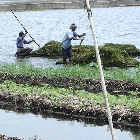By: T.V. Padma
Send to a friend
The details you provide on this page will not be used to send unsolicited email, and will not be sold to a 3rd party. See privacy policy.
Climate change is a reality in developing regions, who say the international community must not neglect better adaptation strategies
"My mother-in-law taught me how to cook over flood waters — my mother couldn’t teach me as she lives in a drought area," smiles 40-year-old Shanti Lata Mazumdar, resident of the increasingly flood-prone Gopalgram village, 150 kilometres south of Bangladesh’s capital Dhaka.
Cooking on a stove perched on a bed amid flood waters is just one of the problems for people in Gopalgram. Water contamination and diarrhoea outbreaks in humans and cattle are widespread, and crops and fish are washed away — while water rats nibble away at what’s left.
Gopalgram lies on a low-lying plain that is frequently flooded by the swelling Ganges and Jamuna rivers, and is one of many poor areas that will be on the receiving end of the potentially disastrous effects of global warming. Those affected will need to adapt to climate change, with many oblivious to the causes and most of the perpetrators in industrialised countries thousands of miles away.
Now, the latest research indicates that adaptation could be more pressing than previously thought. For many, pockets of local knowledge may not be enough for coping with increased storms and floods; more drought and heat; and less predictable weather patterns.
Techniques from across a region and further afield, new technologies and more resources and funding will all be needed by those most affected in least developed countries (LDCs). The challenge is to move adaptation strategies up the political agenda — and fast.
Climate — changing rapidly
At a meeting in Copenhagen in March 2009, an international alliance of research universities warned of possible "dangerous climate change", in which unabated emissions of greenhouse gases could lead to an abrupt or irreversible climate shift.
The group’s update on scientific findings about climate change, summarised in a report released at a UN meeting in Bonn in June 2009, warns that the effects of climate change will be much worse and quicker than previously believed.

Culprits? Industralised countries thousands of miles away
Flickr/destro100
If society does not use existing technological, behavioural and managerial tools to deal with climate change, adaptation will be difficult, warns Katherine Richardson, vice-dean of the faculty of science at the University of Copenhagen and chair of the university alliance.
Copenhagen will host a major international climate meeting in December that will address — among other issues — how to provide LDCs with the money and the technology needed for adaptation.
Tapping local knowledge
Meanwhile, governments, donors, academics and nongovernmental organisations (NGOs) have begun to document and understand local perceptions of changing weather patterns and coping mechanisms. Their insights could lead to better national and international adaptation strategies.
Adaptation has to work on two fronts at the same time, as Terry Cannon, reader in development studies at the University of Greenwich, London, pointed out at an international conference on community adaptation held in Dhaka in February 2009. Communities need to adapt to everyday changes in patterns of rainfall, temperature, and crop and livestock diseases — and also deal with disasters when they occur.
Millions of poor communities across Asia and Africa have a storehouse of traditional knowledge to fall back on during hard times. In Gopalgram and similar water-logged areas, farmers create floating gardens, using abundant water hyacinths as an organic base on which to cultivate fast-growing vegetables, spices and medicinal herbs.
They have raised the floors of their huts and the beds of vegetable plots and tube wells to avoid submergence, set up nurseries to plant flood-tolerant trees, and built traps for water rats, experts reported at the Dhaka conference.
In Sunderbans, the world’s largest mangrove forest, shared by Bangladesh and India, farmers are changing to a multiple cropping system, supplementing rice crops with rearing ducks and fish in inundated ponds, and growing vegetables on floating gardens.
In Nepal, a Himalayan country threatened by glacier melt, farmers have developed hanging nurseries and seed storage banks on higher ground, and sow seeds on soil heaps to avoid flood waters washing them away. They have diversified to stress-tolerant wild brinjals and winter beans; and intercrop rice with maize, tomatoes and chillies. Others are working on flood warning mechanisms, and building embankments along rivers and shallow tube wells to collect water.
"Building on local knowledge and farming innovations is the way to promote community-based adaptation," says Bimal Raj Regmi, senior programme officer at Local Initiatives for Biodiversity Research and Development, a Kathmandu-based NGO. "Low-cost technologies and approaches will be meaningful for poor households."
Meanwhile, farmers in south-eastern Benin — who fish along the Oueme river and grow corn, cassava, cowpeas and leafy vegetables for a living — are worried about the increasingly unpredictable and disappearing rainfall in their area.
"People’s adaptation to environmental change [along the Oueme] combines technical fixes such as faster-maturing crops and seed banks with institutional support such as social networks," says Krystel Dossou, an agricultural economist at Organisation of Women’s Management of Energy, Environment and Integrated Development in Benin.



Farmers create floating gardens on which to grow vegetables
Flickr_LEISA-Network
Widening the knowledge net
But, adds Abdelouahid Chriyaa, from the Regional Center for Agricultural Research in Oujda, Morocco, a country also experiencing changes in temperatures and rainfall, most local populations are not fully informed about available technologies, subsidies and drought-alleviating measures. "There is a need for technology transfer, information and dissemination," says Chriyaa.
To help ensure information on local adaptation efforts does not remain isolated, the Dhaka conference announced a global initiative to share knowledge and experiences on community adaptation strategies (see Poor communities get help with climate adaptation).
"We need to broker a collaboration between researchers and practitioners on the ground," observes Saleemul Haq, former head of the climate science division at the UK-based International Institute for Environment Development, who is establishing an international climate adaptation centre in Bangladesh.
International donor agencies are also pitching in. Climate Change Adaptation in Africa, a project of Canada’s International Development Research Centre and the UK’s Department for International Development, are building the capacity of the African people to innovate and adapt to climate change in ways that benefit the most vulnerable.
Funding challenges at Copenhagen
Community adaptation to climate change is one of the key issues that will be addressed at the international climate summit in Copenhagen in December.
An agreement in Copenhagen should place adaptation on an equal footing with cutting emissions , says Jakob Andersen, an advisor with Denmark’s Ministry of Climate and Energy. It should also "provide a solid platform to tackle longer-term consequences of climate change; focus on the poorest and most vulnerable; and deliver funding for short-term and immediate needs of LDCs.”
The challenges are many. One is agreeing the adaptation funds needed — as many as six estimates have been published in the last two years. The United Nations Framework Convention on Climate Change (UNFCC) estimates that an additional US$28–67 billion will be needed in its target year of 2030 to meet the adaptation needs of developing countries.
The World Bank estimates that investments for ‘climate proofing’ in low- and middle-income countries could cost US$10–40 billion a year. And a United Nations Development Programme report in 2007–08 estimates adaptation investments worth US$86 billion are needed by 2015.
Under the UNFCC, adaptation funds can come from four sources: the LDC fund; the special climate change fund; the Global Environment Facility Fund trust; and the adaptation fund. The World Bank has an additional US$6.34 billion pilot programme on climate resilience to aid adaptation activities.
Developed countries are reluctant to commit to specific contributions before developing countries work out detailed assessment studies on mapping, agriculture planning and disaster preparedness. But many LDCs do not have capacity for this and the only contribution available now is less than US$200 million from a fund designated for LDCs.
One of the most difficult issues is devising a mechanism for money that is separate from official development assistance or foreign aid.
"The close linkage between adaptation and development poses a peculiar paradox," says Anand Patwardhan, professor at the Indian Institute of Technology, Mumbai. "Donor countries fear that ‘normal’ development can get put under adaptation projects, thus opening the floodgates for demands for resources."
Industrialised countries want a clear consensus on the difference between adaptation and normal development process.



Adaptation strategies include a mix of ‘hard’ technologies such as piping and irrigation systems, and ‘soft’ technologies
Flickr/uncultured
"There are no immediate signs of adequate and new financing mechanisms for adaptation to meet developing countries’ expectations," says Katrine Krogh Andersen, senior advisor at Denmark’s Ministry of Climate and Energy, who will head the country’s negotiations at the summit.
But some ideas are emerging, says Patwardhan. For example, additional activities qualifying as adaptation could include climate-proofing activities such as altering roads and buildings, or improving surveillance of vector-borne diseases to provide both development and adaptation benefits.
Technology — ‘patchy’ at best
Besides financial deadlocks, adaptation science and technology are patchy and have not trickled down to poor countries. (See Report highlights patchy oversight for adaptation).
Adaptation strategies include a mix of ‘hard’ technologies such as sea walls, reservoirs, and piping and irrigation systems, and ‘soft’ technologies such as crop rotation patterns and biodiversity knowledge. For example, an early warning system for natural disasters includes measuring devices and computer inputs, and knowledge and skills for early evacuation.
Despite their crucial role in adaptation strategies, UNFCC discussions on an agreement after the Kyoto protocol expires in 2012 have failed to address technologies, states a 2009 report of CIDSE-CARITAS International, a network of Catholic relief service organisations. The chief reasons are fragmentation of talks under various negotiating tracks and the heavy priority given to emission-reduction technologies.
One track focuses on funding of technologies, another on low-carbon technologies — with little awareness within each on the range of technologies that exist to help developing countries adapt to a changing climate. "The adaptation agenda gets fragmented when there is a need for a holistic and integrated view," observes Patwardhan.
Also, although there has been considerable progress in understanding and predicting climate change at continental and larger scales, gaps still remain at smaller scales — finer ‘spatial’ levels (regional, national, local) and ‘temporal’ scales (sub-daily, daily, monthly, yearly or decadal).
"How well we adapt depends on how good the science is," points out Atiq Rahman, director of the Bangladesh Centre for Advanced Studies. "Bad science will not give us good policies."
But residents of Gopalgram and many other areas facing up to changing weather do not have the luxury of time to wait for adaptation to rise up the agenda. As Shailesh Nayak, secretary of India’s Ministry of Earth Sciences, comments: "Climate change is real and is already happening. We all need to think and plan differently."













